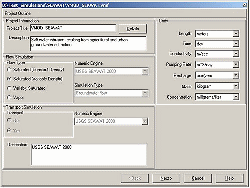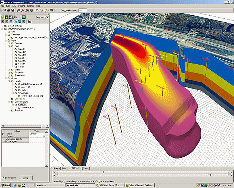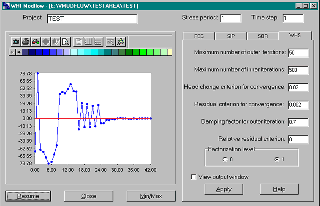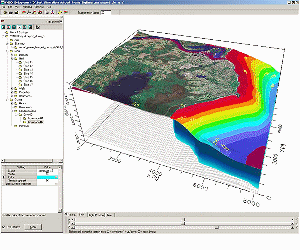|
VARIABLE DENSITY FLOW
|
The groundwater flow equation
usually implemented into a model is for relatively pure water, with low total dissolved
solids (TDS) and solute concentrations. However, sometimes this
is not the case, and the flow equation needs to accommodate solutions
with density effects. These situations are treated
differently, and in this newsletter we will discuss some of the
reasons for being treated differently, and what is done to model them
properly.
1. What
is density?
2. What effects the density of a solution?
3. When does density become important when solving for groundwater flow?
4. How do density effects change the representative numerical
equations?
5. When would I use the variable density
flow equations?
Back to top of
Newsletter
|
|
1. What
is density?
Density is defined as the
mass per unit volume; it is the ratio of the mass of an amount of
matter to the volume occupied by it.
Back to
Variable Density Flow |
|
2. What
effects the density of a solution?
There are many things that
effect the density of a solution. An obvious parameter that
effects density of solutions is the TDS, or total dissolved solids.
The higher the TDS, the higher the density of the water due to the
inclusion of more elements (i.e. Ca, Mg, Fe, etc.). In addition
to TDS, temperature plays a large role in the density of a solution.
The density of water will increase when heated or cooled from a temperature of 4oC. For example, water at 4oC
has a density of approximately 0.999973 gm/cm3 whereas
water at 50oC has a density of approximately 0.988047 gm/cm3.
This property of water is due to the cohesive nature of the hydrogen
bonds, essentially how closely packed the atoms are. Therefore,
when dealing with solutions with high TDS, or temperatures either
higher or lower than normal groundwater temperatures, density effects
may play an important role.
Back to
Variable Density Flow |
|
3. When
does density become important when solving for groundwater flow?
The standard flow models
(without variable density effects) assume that the density of
groundwater remains constant, at approximately 1.0 gm/cm3. This
assumption is typically valid for groundwaters with low TDS (total
dissolved solids) and temperatures within the normal shallow
groundwater range (~8oC +/-3oC in northern
latitudes). However, in
circumstances when there is a high TDS value, such as sea water or
landfill leachate, or in high temperature situations such as
geothermal regions, these assumptions may not be valid, and therefore
density effects must be taken into account. There is no rule for
at what TDS or temperature value you must use variable density flow,
it is dependent on each site, and the precision required.
Back to
Variable Density Flow
|
|
4.
How do density effects change the representative numerical equations?
To form the usual groundwater
flow equations used in groundwater modelling, assumptions are made
regarding the variation of density in the system. These
assumptions are that density does not change spatially or temporally
within the modelled domain.
When these assumptions cannot
be made, a flow solution based on the non-linear multiphase flow
formulation must be used. The non-linearity of this equation
typically results in greater run times, and difficulty in convergence.
Back to
Variable Density Flow
|
|
5. When
would I use variable density flow equations?
There are many reasons for
using the variable density flow equations. Some of these, as
previously mentioned, include sea water, or sea water intrusion,
landfill leachate or geothermal flow. Other instances may
include brine disposal, waste injection into saline aquifers or heat
storage in aquifers.
Variable density flow can
play an important role in the groundwater flow system in many
circumstances. There are several commercial models available
which can readily solve these problems, such as the new
Visual MODFLOW
4.1.
Back to
Variable Density Flow |
There are many resources
available for more information on variable density flow. For this newsletter the following
textbooks were used:
Anderson, M.P. and W.W.
Woessner (1992). Applied Groundwater Modeling: Simulation of
Flow and Advective Transport. Published by Academic Press
Inc., San Diego, California, USA.
Bear, J. (1972). Dynamics
of Fluids in Porous Media. Published by Dover Publications Inc.,
New York, USA.
Fetter, C.W. (1988).
Applied Hydrogeology, Third Edition. Published by
Prentice-Hall, Inc., New Jersey, USA.
Freeze, R.A., and J.A. Cherry
(1979). Groundwater. Published by Prentice-Hall,
Inc., New Jersey, USA.
Return to top of
Newsletter
|
|
VISUAL
MODFLOW 4.1
Click here to download a demo of Visual MODFLOW 4.1
Click here for the best price on Visual MODFLOW 4.1
Back to top of
Newsletter
|
Visual MODFLOW has long been
recognized by many as the industry standard in groundwater modelling.
This most recent update to the Visual MODFLOW package gives users
several new tools and capabilities that previous versions do not.
These new tools, and reasons for upgrading to the newest version of
Visual MODFLOW 4.1 are described below.
|
Why Should I
Upgrade to
Visual MODFLOW
4.1?
1. Easier to Use
2. Most Recent Updates to Models
3.
Faster Run Times
4.
Capable of Variable Density Flow
Return to top of
Newsletter
|
|
|
1. Easier to Use
The new version of Visual
MODFLOW has an improved Project Creation Wizard which is now designed
to help the user select the most appropriate flow and transport
numeric engines for their project. The wizard also guides the
user through selecting and entering project information and run time
options, in addition to many other features.
Return to the
capabilities of Visual
MODFLOW
|

Click to enlarge
picture |
|
|

Click to
enlarge picture
|
2. Most Recent Updates
to Models
This
version of Visual MODFLOW includes the latest versions of
MODFLOW-2000 from the USGS, in addition to the latest MT3DMS engine.
Return to the capabilities of Visual MODFLOW
|
|
|
3. Faster Run Times
To decrease
the run times of models, a new solver, the GMG solver, has been
implemented into Visual MODFLOW. This solver has been
demonstrated to greatly reduce the model run times relative to other
solvers using comparable amounts of memory. In addition, the
SAMG solver has been updated in Visual MODFLOW 4.1.
Return to the capabilities of Visual MODFLOW
|

Click to enlarge picture |
|
|

Click to enlarge picture
|
4. Now capable of
variable-density flows
The biggest
update to Visual MODFLOW is the inclusion of the USGS's SEAWAT, a
varibale density flow engine. This enables users to solve
variable density problems such as seawater intrusion, and landfill
leachate contamination. SEAWAT combines the flow code, MODFLOW,
with the solute transport code, MT3DMS, to form a single program to
solve coupled flow and solute transport of variable density systems.
Return to the capabilities of Visual MODFLOW
|
|
|

